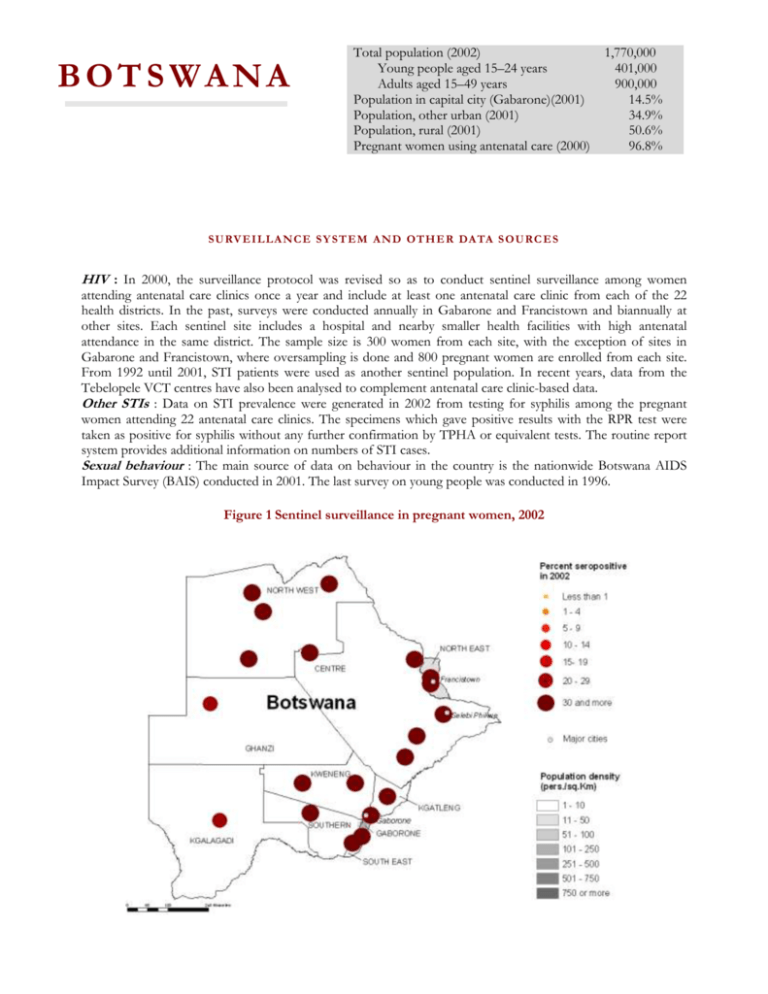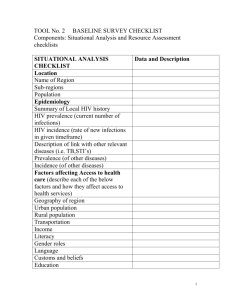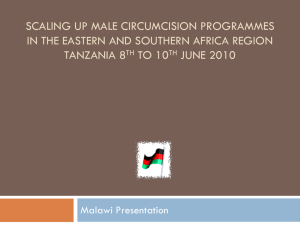
BOTSWANA
Total population (2002)
Young people aged 15–24 years
Adults aged 15–49 years
Population in capital city (Gabarone)(2001)
Population, other urban (2001)
Population, rural (2001)
Pregnant women using antenatal care (2000)
1,770,000
401,000
900,000
14.5%
34.9%
50.6%
96.8%
S U RV E I L L A N C E S Y S T E M A N D OT H E R DA TA S OU RC E S
HIV : In 2000, the surveillance protocol was revised so as to conduct sentinel surveillance among women
attending antenatal care clinics once a year and include at least one antenatal care clinic from each of the 22
health districts. In the past, surveys were conducted annually in Gabarone and Francistown and biannually at
other sites. Each sentinel site includes a hospital and nearby smaller health facilities with high antenatal
attendance in the same district. The sample size is 300 women from each site, with the exception of sites in
Gabarone and Francistown, where oversampling is done and 800 pregnant women are enrolled from each site.
From 1992 until 2001, STI patients were used as another sentinel population. In recent years, data from the
Tebelopele VCT centres have also been analysed to complement antenatal care clinic-based data.
Other STIs : Data on STI prevalence were generated in 2002 from testing for syphilis among the pregnant
women attending 22 antenatal care clinics. The specimens which gave positive results with the RPR test were
taken as positive for syphilis without any further confirmation by TPHA or equivalent tests. The routine report
system provides additional information on numbers of STI cases.
Sexual behaviour : The main source of data on behaviour in the country is the nationwide Botswana AIDS
Impact Survey (BAIS) conducted in 2001. The last survey on young people was conducted in 1996.
Figure 1 Sentinel surveillance in pregnant women, 2002
HIV
In 2002, the median HIV prevalence in women attending antenatal care clinics for all 22 districts was very high
(35.4%). There was little difference between the major urban areas (the capital city Gaborone, Francistown and
Selebi/Phikwe), other urban areas and the 12 rural districts (Figure 2). Only one district, Ganzi in the Kalahari,
had a HIV prevalence of <25% (18.8%), while prevalence was highest in Selebi/Phikwe, where nearly half of all
pregnant women were infected (48.1%).
HIV prevalence has been >30% at most antenatal care clinics since the mid 1990s. Comparison of prevalence in
the 22 districts between 2001 and 2002 shows that there was a decrease in 13 districts, an increase in eight
districts and no change in one district. HIV infection trends in Gaborone and Francistown are illustrated in
Figure 3. During the past five years, HIV prevalence levels have remained at around 40%.
HIV prevalence among STI patients also indicate high levels of infection, ranging from 24.3% in Francistown to
73.9% in Gabarone, in 2001. During 2000-2002, 16,784 women and 14,146 men were tested in the Tebelopele
VCT centres (13 centres in 2002). In 2002, HIV prevalence was 39.1% among women and 28.7% among men.
Female prevalence peaked at 50.6% at age 30-34 years, while male prevalence reached a high of 48.7% at age 3539 years.
Figure 2 Median HIV prevalence among women
attending anenatal care clinics, by
location, Botswana, 2002
Figure 3 Trend in median HIV prevalence
among women atttending antenatal care
clinics in Gaborone and Francistown,
Botswana, 1992–2002
40.2
37.0
40
30
Gaborone
40
Prevalence (%)
All 22
districts
10
20
02
20
01
19
92
20
00
0
Major urban sites include Francistown, Gabarone and
Selebi/Phikwe
19
99
Rural
districts
19
98
Other
urban
districts
19
97
Major
urban
20
19
96
0
30
19
95
10
19
94
20
19
93
Prevalence (%)
32.8
Francistown
50
35.4
OT H E R S T I s
Median syphilis seroprevalence among women attending antenatal care clinics was 2.4%, and ranged from 0.0%
in Boeti to 7.3% in Kgalagadi.
The total number of STI cases reported annually was between 200,000 and 208,000 from 1995 to 1999 (the most
recent year with available data). Among women attending family planning clinics in 2002, chlamydial infection
was the most prevalent infection accounting for about 13% of all STIs, followed by trichomoniasis. In a study of
the etiology of genital ulcerations, HSV-2 was detected in 59% of cases, 2% were due to syphilis, 1% were
chancroid and in 38% of cases no agent was identified.
S E X UA L B E H AV I OU R
According to the BAIS in 2001, 25% of men and 11% of women reported having had more than one sexual
partner in the last year. The survey indicated that condom use was relatively high among both men and women.
Nearly 80% of men and 70% of women who reported having had sex with a non-spousal non-cohabiting sexual
partner(s) in the last year used a condom at last sex.
Figure 4 Median HIV prevalence among young
women aged 15–24 years attending
antenatal care clinics, by location,
Botswana, 2001–2002
40
2001
34.5
2002
Prevalence (%)
31.2
32.934.0
33.0
31.1
Rural
districts
All 22
districts
28.929.6
30
20
10
0
Major urban Other urban
M O R B I D I T Y A N D M OR TA L I T Y
From 1995 to 1999, the crude mortality rate in Botswana increased by 72.3%, with an annual increase of
approximately 15%. Between 1998 and 1999, nearly one in every five deaths was attributed to HIV/AIDS.
The total number of tuberculosis cases registered during 2001 was 10,248 ( which corresponds to a tuberculosis
notification rate of 620 per 100,000 population) and 86% of these were cases of pulmonary tuberculosis (Figure
5). Notification rates were highest among women aged 25–34 years and in men aged 35–44 years.
20
01
20
00
19
99
19
98
19
97
19
96
19
95
19
94
19
93
19
92
800
700
600
500
400
300
200
100
0
19
91
Rate per 100,000 population
Figure 5 Trend in new cases of tuberculosis per 100,000 population, Botswana, 1991–2001
YO U N G P E OP L E
Sexual behaviour
HIV : The prevalence of HIV among young women aged 15-24 years attending antenatal care clinics in
Botswana is high, which indicates a high incidence of HIV infection. Figure 4 shows the median HIV prevalence
among antenatal care clinic attendees aged 15-24 years in 2001 and 2002. About one-fifth of women aged 15-19
years were infected. HIV prevalence was already 35.1% among women who came to the clinic with their first
pregnancy.
Age at first sex : In 2001, the BAIS showed that 20% of the young people surveyed reported having had first
sex by the age of 17 years, with 3.0% of young men and 2% of young women reporting having had sex at or
before age 15 years.
Premarital sex : A high proportion (57%) of young people surveyed in 2000 reported being sexually active. The
1998 DHS found that 18% of young women and 53% of young men had engaged in premarital sex in the last
year.
Condom use : Use of condoms is reportedly high among young people. Among respondents aged 15-24 years
who reported having had sex with a non-marital non-cohabiting partner in the last year in 2001, 88% of the
young men and 75% of the young women used a condom at last sex.
C O N C L U S I O N A N D R E C OM M E N DA T I O N S
Extremely high levels of HIV prevalence have been maintained in the HIV/AIDS epidemic in
Botswana since the mid 1990s. High prevalence rates are distributed throughout the country,
including most rural districts. Prevalence rates among young pregnant women are also very high
and there is little evidence of a decline. HIV/AIDS is contributing to a reversal of age-specific
mortality patterns, with increasing proportions of younger people dying.
Only limited data on sexual behaviour are available. A recent survey suggests that moderately high
levels of multiple partnerships, premarital sex and high levels of condom use, particularly among
young people, are likely to have an impact on the spread of HIV.
To strengthen surveillance, it can be recommended that:
HIV : The new HIV sentinel surveillance system among women attending antenatal care clinics is
operating well and should be consolidated.
Other STIs : Strengthening of STI surveillance, including the generation of better data on the etiology of
STIs, is important.
Sexual behaviour : A more intense and focused system for monitoring sexual behaviours among young
people should be developed.
REFERENCES
[1] The National AIDS Coordinating Agency, Botswana. Second generation HIV/AIDS surveillance: a technical report, November 2002.
[2] The National AIDS Coordinating Agency, Botswana. HIV sero-prevalence sentinel survey amongst pregnant women and men with
STI: a technical report, 2000 and 2001.
[3] UNICEF. UNICEF Global Database; Antenatal Care (http://www.childinfo.org/eddb/antenatal/database1.htm). Accessed June
2003.
[4] United Nations Population Division. World population prospects: the 2002 revision. (http://esa.un.org/unpp/). Accessed June 2003.
[5] WHO/AFRO database on HIV surveillance. Accessed June 2003.
[6] WHO/AFRO. HIV surveillance report for Africa, 2000. November 2001
(http://www.afro.who.int/aids/surveillance/resources/hiv_surveillance_report_2000.pdf).




![[CLICK HERE AND TYPE TITLE]](http://s3.studylib.net/store/data/007215999_1-000ccbdd38bb3e465714adeb5f197f4f-300x300.png)

